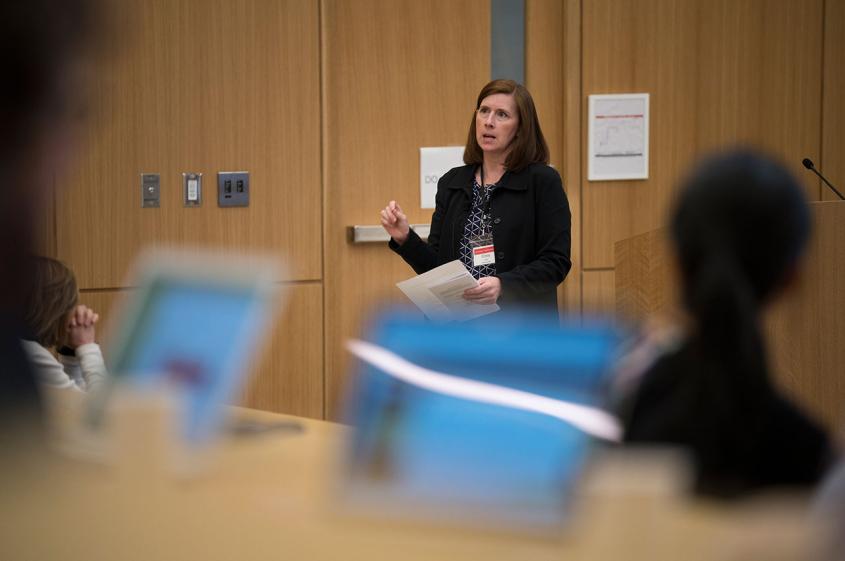Integrative immunology: symposium unites Cornell scientists from Ithaca, New York City campuses
Cornell experts in immunology from both Ithaca and New York City gathered last week at the College of Veterinary Medicine for the Immunology in Health and Disease Symposium, a two-day event that sparked new ideas for collaboration between Weill Cornell Medicine and their upstate colleagues. “The event enabled us to identify ways we can use the tools in one field to inform and drive discovery in the other,” says event co-organizer Dr. Cynthia Leifer, associate professor of immunology. “And it really showcased how many opportunities there are to foster cross-collaboration.”
The symposium marks the fourth academic cross-campus conference funded by the Cornell Academic Integration Initiative, which aims to build integration between Weill Cornell Medicine and their Ithacan colleagues. “We want to catalyze synergy,” said Dr. Gary Koretzky, dean of Weill Cornell Graduate School of medical sciences and the vice dean for research of Weill Cornell Medicine who heads up the initiative. “We want to overcome what’s perceived as a barrier—this idea that people don’t know much about each other across each campus, and identify possibilities for all types of collaborations.”
The immunology event was devised by Leifer and her Cornell immunology colleagues, and co-organized with Dr. Virginia Pascual, the Director of the Gale and Ira Drukier Institute for Children’s Health at Weill Cornell Medicine. It featured talks, poster sessions, and breakout sessions designed to strategize further ways to strengthen collaboration between campuses.
Bench and bedside research
Faculty talks spanned both basic and applied research; Dr. Avery August, professor of immunology and vice provost for academic affairs, gave an overview of his lab’s work on ITK, a key immune cell regulator that August likened to a turntable that provides nuanced tuning between inflammatory and anti-inflammatory responses within the body. Dr. David Artis, director of the Jill Roberts Institute for Research in Inflammatory Bowel Disease and the Michael Kors Professor of Immunology at Weill Cornell Medicine, discussed the role of gut microbes in host immune cell function, “I think this is the forefront of human medicine, and represents the next frontier of drug discovery,” he said.
Presentations also explored impacts in veterinary medicine. Dr. Elia Tait Wojno, assistant professor of microbiology and immunology, discussed innate immune responses to allergies and helminth infection, discussing her search for therapeutic targets for canine and human allergic disease. “By studying some of the mechanisms that control type 2 immune responses, we can begin to develop control and treatment strategies for both these types of inflammation,” Tait Wojno said.
Dr. Kristy Richards also discussed dogs in her presentation on comparative lymphoma research. As an associate professor of biomedical sciences with dual appointments at CVM and WCM, Richards leverages the canine lymphoma patient population that comes to Cornell University Hospital for Animals as clinical models for both canine and human cancer drug development, including immunotherapy studies. “In dogs, the immune system is intact and educated, allowing a much more accurate assessment of immunotherapeutic affects,” said Richards. Another benefit, she added is “easy access to repeat biopsies—with a little bit of peanut butter.”
New tools
New technologies and methods were another hot topic of discussion. Dr. Pamela Chang, assistant professor of immunology, discussed her work in chemical optogenetics. “Current tools aren’t fast enough to interrogate rapid biological responses or special relationships between cells,” said Chang. “We need new tools with spatial and temporal precision.” Her group has tackled that challenge by using light-controlled enzymes that be used to activate and inactivate immune cells at specific timescales and locations. After perfecting this tool in vitro, Chang said their next step is to test the strategy in mouse models.
Dr. Cindy Leifer uses stiffness instead of light to manipulate immune cells. “There are many different changes in the body, including aging, infection and chronic inflammation that can change the biochemical and the biophysical microenvironment of the immune cells, but how these influence the cells is not well understood,” said Leifer. Her group created an acrylamide gels with precisely defined stiffnesses mimicking normal and diseased tissue and tested how macrophages respond to softer or stiffer environments. Leifer said that, “Almost everything we’ve measured in our macrophages has been affected by stiffness,” including the cells size, morphology and pro-inflammatory signaling. They plan to begin manipulating biophysical environments in vivo with an eventual aim to find novel pharmacological targets.
In addition to faculty talks, trainees presented posters on their latest research, with three trainees receiving awards for best poster presentations. Simon Frueh, a graduate student in the Tait Wojno lab, won for his presentation on Type 2 inflammatory cellular immune mechanisms in canine atopic dermatitis. Jim Castellanos, an MD-PhD student at WCM, won for his poster demonstrating the mechanistic contributions of TNF-like ligand 1A in inflammatory bowel disease in humans. Lu Huang, a postdoctoral researcher in Dr. David Russell’s lab at CVM, won for his poster that detailed how two distinct populations of lung macrophages act as either permissive or restrictive hosts to Mycobacterium tuberculosis.
Powers combined
The conference culminated in breakout sessions aimed at catalyzing ideas on strengthening research collaboration between campuses. They identified the need for improved communication and information sharing as primary goals moving forward, as well as making the symposium an annual event.
Overall, the conference highlighted the complementary strengths of each institution. “At Weill, they have large numbers of human samples and can do extraordinary work in terms of big data and cell sequencing,” said Leifer. “However, they have limits in being able to interrogate those subjects. We have the ability to investigate our models at a deeper mechanistic level, and also have extraordinary bioengineering and biochemical technology resources here.” With the Cornell Academic Integration Initiative actively working to reduce paperwork and other logistical barriers to collaboration, both Cornell campuses may soon benefit from these complementary strengths.
-By Lauren Cahoon Roberts





